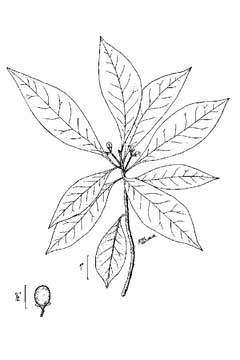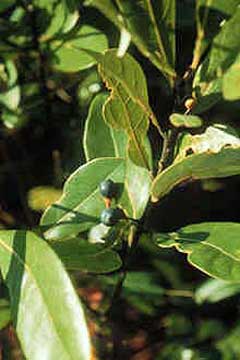 |
|
USDA-NRCS PLANTS Database / USDA NRCS. Wetland flora: Field office illustrated guide to plant species. USDA Natural Resources Conservation Service. |
 |
| USDA-NRCS PLANTS Database |
Translate this page:
Summary
Bloom Color: Green, White. Main Bloom Time: Early spring, Late spring, Mid spring. Form: Rounded, Spreading or horizontal.
Physical Characteristics

 Persea borbonia is an evergreen Tree growing to 15 m (49ft 3in) at a medium rate.
Persea borbonia is an evergreen Tree growing to 15 m (49ft 3in) at a medium rate.
See above for USDA hardiness. It is hardy to UK zone 9. It is in leaf all year, in flower from April to May, and the seeds ripen from September to October. The species is hermaphrodite (has both male and female organs).
Suitable for: light (sandy) and medium (loamy) soils. Suitable pH: mildly acid, neutral and basic (mildly alkaline) soils. It cannot grow in the shade. It prefers moist soil.
UK Hardiness Map
US Hardiness Map
Synonyms
Plant Habitats
Woodland Garden Secondary; Sunny Edge;
Edible Uses
Edible Parts:
Edible Uses: Condiment
The fresh or dried leaves can be used as a flavouring in soups etc[229].
References More on Edible Uses
Medicinal Uses
Plants For A Future can not take any responsibility for any adverse effects from the use of plants. Always seek advice from a professional before using a plant medicinally.
Abortifacient Analgesic Antirheumatic Appetizer Emetic Febrifuge
Red bay was widely employed medicinally by the Seminole Indians who used it to treat a variety of complaints, but especially as an emetic and body cleanser[257]. It is little, if at all, used in modern herbalism. The leaves are abortifacient, analgesic, antirheumatic, appetizer, emetic and febrifuge[257]. An infusion can be used to abort a foetus up to the age of four months[257]. An infusion is also used in treating fevers, headaches, diarrhoea, thirst, constipation, appetite loss and blocked urination[257]. A strong decoction is emetic and was used as a body purification when treating a wide range of complaints[257]. A decoction of the leaves is used externally as a wash on rheumatic joints and painful limbs[257].
References More on Medicinal Uses
The Bookshop: Edible Plant Books
Our Latest books on Perennial Plants For Food Forests and Permaculture Gardens in paperback or digital formats.

Edible Tropical Plants
Food Forest Plants for Hotter Conditions: 250+ Plants For Tropical Food Forests & Permaculture Gardens.
More

Edible Temperate Plants
Plants for Your Food Forest: 500 Plants for Temperate Food Forests & Permaculture Gardens.
More

More Books
PFAF have eight books available in paperback and digital formats. Browse the shop for more information.
Shop Now
Other Uses
Wood
Wood - hard, heavy, close-grained, very strong, rather brittle[82, 229, 235]. It weighs 40lb per cubic foot[235]. The wood works well and is suitable for interior uses such as cabinets, but trees with large straight trunks are not sufficiently common to make the tree of commercial interest[229].
Special Uses
Food Forest
References More on Other Uses
Cultivation details
Landscape Uses:Pest tolerant, Seashore, Specimen, Street tree. We have found no cultivation details for this species in Britain, though the tree is likely to require a well-drained light to medium soil in a sunny sheltered position[K]. It is only likely to be hardy in the mildest areas of the country[11]. Special Features:Attracts birds, Attractive foliage, North American native, Fragrant foliage, Attracts butterflies, Inconspicuous flowers or blooms. The plant is heat tolerant in zones 12 through 8. (Plant Hardiness Zones show how well plants withstand cold winter temperatures.
Plant Heat Zones show when plants would start suffering from the heat.
The Plant Heat Zone map is based on the number of "heat days" experienced in a given area where the temperature climbs to over 86 degrees F (30°C).
At this temperature, many plants begin to suffer physiological damage. Heat Zones range from 1 (no heat days) to 12 (210 or more heat days).
For example Heat Zone. 11-1 indicates that the plant is heat tolerant in zones 11 through 1.) For polyculture design as well as the above-ground architecture (form - tree, shrub etc. and size shown above) information on the habit and root pattern is also useful and given here if available. The plant growth habit is a standard with a non-suckering single trunk [1-2]. An evergreen.
References Carbon Farming Information and Carbon Sequestration Information
Temperature Converter
Type a value in the Celsius field to convert the value to Fahrenheit:
Fahrenheit:
The PFAF Bookshop
Plants For A Future have a number of books available in paperback and digital form. Book titles include Edible Plants, Edible Perennials, Edible Trees,Edible Shrubs, Woodland Gardening, and Temperate Food Forest Plants. Our new book is Food Forest Plants For Hotter Conditions (Tropical and Sub-Tropical).
Shop Now
Plant Propagation
Seed - we have no information for this species but suggest sowing the seed in a greenhouse in early spring. Prick out the seedlings into individual pots when they are large enough to handle and grow them on in the greenhouse for their first 2 winters. Plant them out into their permanent positions in early summer and give some protection from winter cold for their first winter or two outdoors.
Other Names
If available other names are mentioned here
Native Range
NORTHERN AMERICA: United States, Alabama, Arkansas, Delaware (south), Florida, Georgia, Louisiana, Maryland (southeast), Mississippi, North Carolina, South Carolina, Virginia (southeast), Texas, SOUTHERN AMERICA: Bahamas,
Weed Potential
Right plant wrong place. We are currently updating this section.
Please note that a plant may be invasive in one area but may not in your area so it's worth checking.
Conservation Status
IUCN Red List of Threatened Plants Status :

Growth: S = slow M = medium F = fast. Soil: L = light (sandy) M = medium H = heavy (clay). pH: A = acid N = neutral B = basic (alkaline). Shade: F = full shade S = semi-shade N = no shade. Moisture: D = dry M = Moist We = wet Wa = water.
Now available:
Food Forest Plants for Mediterranean Conditions
350+ Perennial Plants For Mediterranean and Drier Food Forests and Permaculture Gardens.
[Paperback and eBook]
This is the third in Plants For A Future's series of plant guides for food forests tailored to
specific climate zones. Following volumes on temperate and tropical ecosystems, this book focuses
on species suited to Mediterranean conditions—regions with hot, dry summers and cool, wet winters,
often facing the added challenge of climate change.
Read More
Expert comment
Author
(L.)Spreng.
Botanical References
229235270
Links / References
For a list of references used on this page please go here
Readers comment
© 2010, Plants For A Future. Plants For A Future is a charitable company limited by guarantee, registered in England and Wales. Charity No. 1057719, Company No. 3204567.